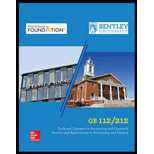
GB 112/212 MANAGERIAL ACC. W/ACCESS >C<
17th Edition
ISBN: 9781260218831
Author: Libby
Publisher: MCG CUSTOM
expand_more
expand_more
format_list_bulleted
Concept explainers
Question
Chapter 2, Problem 2.9ME
To determine
Prepare the appropriate T-accounts of Company D, and determine the ending balance of each account.
Expert Solution & Answer
Want to see the full answer?
Check out a sample textbook solution
Students have asked these similar questions
The amount allocated to ending inventory on APril
What are the budgeted cash payments for November?
Can you please solve this questions
Chapter 2 Solutions
GB 112/212 MANAGERIAL ACC. W/ACCESS >C<
Ch. 2 - Prob. 1QCh. 2 - Define the following: a. Asset b. Current asset c....Ch. 2 - Explain what the following accounting terms mean:...Ch. 2 - Why are accounting assumptions necessary?Ch. 2 - For accounting purposes, what is an account?...Ch. 2 - What is the fundamental accounting model?Ch. 2 - Prob. 7QCh. 2 - Explain what debit and credit mean.Ch. 2 - Prob. 9QCh. 2 - Prob. 10Q
Ch. 2 - Prob. 11QCh. 2 - Prob. 12QCh. 2 - How is the current ratio computed and interpreted?Ch. 2 - Prob. 14QCh. 2 - Prob. 1MCQCh. 2 - Which of the following is not an asset? a....Ch. 2 - Total liabilities on a balance sheet at the end of...Ch. 2 - The dual effects concept can best be described as...Ch. 2 - The T-account is a tool commonly used for...Ch. 2 - Prob. 6MCQCh. 2 - The Cash T-account has a beginning balance of...Ch. 2 - Prob. 8MCQCh. 2 - At the end of a recent year, The Gap, Inc.,...Ch. 2 - Prob. 10MCQCh. 2 - Matching Definitions with Terms Match each...Ch. 2 - Matching Definitions with Terms Match each...Ch. 2 - Identifying Events as Accounting Transactions...Ch. 2 - Classifying Accounts on a Balance Sheet The...Ch. 2 - Determining Financial Statement Effects of Several...Ch. 2 - Prob. 2.6MECh. 2 - Prob. 2.7MECh. 2 - Prob. 2.8MECh. 2 - Prob. 2.9MECh. 2 - Prob. 2.10MECh. 2 - Prob. 2.11MECh. 2 - Computing and Interpreting the Current Ratio...Ch. 2 - Identifying Transactions as Investing or Financing...Ch. 2 - Matching Definitions with Terms Match each...Ch. 2 - Identifying Account Titles The following are...Ch. 2 - Classifying Accounts and Their Usual Balances As...Ch. 2 - Determining Financial Statement Effects of Several...Ch. 2 - Determining Financial Statement Effects of Several...Ch. 2 - Recording Investing and Financing Activities Refer...Ch. 2 - Prob. 2.7ECh. 2 - Recording Investing and Financing Activities...Ch. 2 - Analyzing the Effects of Transactions In...Ch. 2 - Analyzing the Effects of Transactions In...Ch. 2 - Prob. 2.11ECh. 2 - Inferring Investing and Financing Transactions and...Ch. 2 - Recording Journal Entries Nathanson Corporation...Ch. 2 - Prob. 2.14ECh. 2 - Analyzing the Effects of Transactions Using...Ch. 2 - Prob. 2.16ECh. 2 - Prob. 2.17ECh. 2 - Prob. 2.18ECh. 2 - Inferring Typical Investing and Financing...Ch. 2 - Prob. 2.20ECh. 2 - Identifying the Investing and Financing Activities...Ch. 2 - Prob. 2.22ECh. 2 - Identifying Accounts on a Classified Balance Sheet...Ch. 2 - Determining Financial Statement Effects of Various...Ch. 2 - Prob. 2.3PCh. 2 - Prob. 2.4PCh. 2 - Prob. 2.5PCh. 2 - Prob. 2.6PCh. 2 - Prob. 2.1APCh. 2 - Determining Financial Statement Effects of Various...Ch. 2 - Recording Transactions in T-Accounts, Preparing...Ch. 2 - Prob. 2.4APCh. 2 - Accounting for the Establishment of a New Business...Ch. 2 - Prob. 2.1CPCh. 2 - Prob. 2.2CPCh. 2 - Prob. 2.3CPCh. 2 - Prob. 2.4CPCh. 2 - Prob. 2.5CPCh. 2 - Prob. 2.6CPCh. 2 - Prob. 2.7CPCh. 2 - Prob. 2.8CP
Knowledge Booster
Learn more about
Need a deep-dive on the concept behind this application? Look no further. Learn more about this topic, accounting and related others by exploring similar questions and additional content below.Similar questions
- What was Northridge Corporation's net operating income for the year using variable costing?arrow_forwardBeta Tech Solutions Ltd. has a beta of 0.75. If the market return is expected to be 10.5 percent and the risk-free rate is 4.5 percent, what is the company's required return?arrow_forwardI want answer with all working formatarrow_forward
arrow_back_ios
SEE MORE QUESTIONS
arrow_forward_ios
Recommended textbooks for you
 Financial Accounting: The Impact on Decision Make...AccountingISBN:9781305654174Author:Gary A. Porter, Curtis L. NortonPublisher:Cengage LearningCentury 21 Accounting Multicolumn JournalAccountingISBN:9781337679503Author:GilbertsonPublisher:Cengage
Financial Accounting: The Impact on Decision Make...AccountingISBN:9781305654174Author:Gary A. Porter, Curtis L. NortonPublisher:Cengage LearningCentury 21 Accounting Multicolumn JournalAccountingISBN:9781337679503Author:GilbertsonPublisher:Cengage

Financial Accounting: The Impact on Decision Make...
Accounting
ISBN:9781305654174
Author:Gary A. Porter, Curtis L. Norton
Publisher:Cengage Learning

Century 21 Accounting Multicolumn Journal
Accounting
ISBN:9781337679503
Author:Gilbertson
Publisher:Cengage
The KEY to Understanding Financial Statements; Author: Accounting Stuff;https://www.youtube.com/watch?v=_F6a0ddbjtI;License: Standard Youtube License